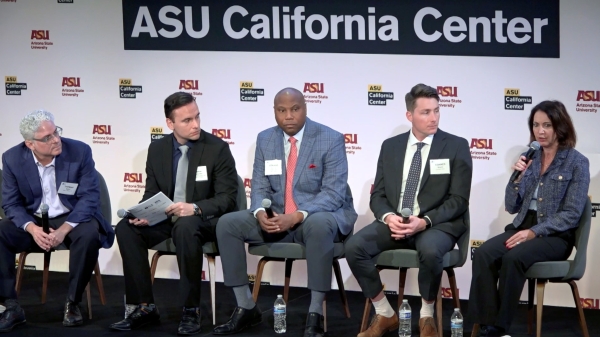It is hard to imagine that something that happened 500 years ago could still influence world events today, but that is exactly what many historians, political scientists and religious studies scholars argue when it comes to the Protestant Reformation.
And that is the question at the heart of a panel discussion that Arizona State University’s Center for the Study of Religion and Conflict will host from 4:30 to 6 p.m. Thursday in Katzin Concert Hall on the Tempe campus.
The Protestant Reformation was set off by Martin Luther, a monk and scholar who wrote a document in 1517 attacking the Catholic Church’s practice of selling “indulgences” as a way to absolve sin.
The popular telling is that he dramatically nailed the document, known as the “95 Theses,” to the door of the Wittenberg Castle church. But reality is much more mundane. Luther hung the document on the door to announce an academic discussion, much like the fliers one sees around campus announcing events such as Thursday’s.
When Luther hung that flier on Oct. 31, 1517, he had no way of knowing that his writings about church doctrine would alter the course of religious and cultural history, setting off civil strife, rebellions and wars in Europe and England that would last more than 130 years and culminate in the establishment of the nation-state system that we know today.
Nor could he have known that his ideas about salvation and the authority of the church would ultimately lead a small group known as the Pilgrims to set sail on the Mayflower in 1619 to establish a religious colony in Massachusetts.
Nor could he have known that the reverberations from this event would still be felt today, in everything from the way religion is practiced to the development of secular governance and modern capitalism.
To address the impact of the Protestant Reformation on the world today, the center has assembled a panel of renowned scholars that includes Susan Schreiner, a historian from the University of Chicago; Daniel Philpott, a political theorist from the University of Notre Dame; Tracy Fessenden, a religious studies professor from ASU; and John Carlson, interim director of the center.
Fessenden, an associate professor in the School of Historical, Philosophical and Religious Studies, spoke with ASU Now in advance of the event to share more about why the Protestant Reformation was so important and what we can understand about religion and conflict in the world today from learning more about it.
Question: Why is the Protestant Reformation important to talk about, 500 years later?
Answer: In a sense, the history of the individual in the West begins with the Protestant Reformation.
In a nutshell, the Reformation moved the focus of religious authority from the church — the institution — to the Bible. That made one’s experience of reading of the Bible the path to knowing the divine will.
The hope of the original reformers was that this would put an end to religious corruption and disputes over authority by settling the question of where truth resides: sola scriptura, only in the word of God. But the outcome could not have been further from what they hoped. Lodging religious authority in the individual’s encounter with scripture ultimately unleashed a hyperpluralism of opinion, of interpretation, of the concept of the good and the options for pursuing it.
A momentous consequence of shifting the locus of religious authority from the church to the Bible was that it empowered the reading subject, the individual, to discern the divine will and the answers to the big questions — and to do so with or against institutional guidance.
The legacy of the Reformation is massive, complicated and mixed — not all good or all bad, but very powerfully formative. It has affected all parts of our society, religious or not.
Q: What did a religious revolution have to do with political and social change?
A: For most of Christian history the church was the temporal authority as well as the spiritual one. The church was the government, basically.
The reason we have church-state separation in modern liberal states has to do with the way that bloody disputes between Christian factions over doctrinal and theological differences came to be settled. If the divine will was to be known sola scriptura, through Bible reading only, still the Bible needed to be interpreted. Rival interpretations matter when these drive the actions of states. But if the state takes itself out of the religion business to focus on politics, law and trade, then rival interpretations essentially come down to individual differences of belief, and these are manageable in civil society. Religion came to be centered on belief, which could vary from person to person, and which no government or other power could compel or enforce. You could believe as you wanted to believe. The state could make laws about behavior but not about belief, which would be left to the individual, and to churches.
As a result, the individual comes to matter more and more, because a tremendous burden of interpretation, of figuring out the will of the divine or the meaning of life or the answers to life’s pressing questions, comes to center on the self. Roman Catholicism did not go away once Protestants began asserting independence from the Roman Catholic Church, just as Judaism didn’t go away when Christians decided that a part of Jewish scripture would be their Old Testament and Christian revelation a New Testament. Both Judaism and Roman Catholicism became modern phenomena alongside Protestantism, and both share in the modern sense that our interior lives are constitutive of who we truly are. But the idea that we have an interior life that matters that much is very much a Reformation product.
Q: What can we understand about religion and conflict in the world today from studying the Protestant Reformation?
A: As Americans, the Protestant understanding that religion is primarily a matter of belief, and that we are free to believe or not as we wish, is something a majority agree on and take for granted. And that’s traced to the Reformation. Most of us, if we thought about it, might say that leaving religious belief up to the individual acknowledges the equality of individuals and protects us equally in our choice of whether and how to practice religion.
But not all religions center on belief, and not all religious practice involves solitary reading and reflection. When we understand religion to be about belief, often we’re making Christianity the implicit norm. For example, in France, there’s still controversy over whether Muslim women can wear headscarves in public. The thinking behind the ban on headscarves is that religious difference is a private matter, and so markers of religious difference don’t belong in public. You can do whatever you want in private, but in the public square we’re all equal. But the Muslim woman would argue that she doesn’t wear a headscarf at home but only in public. There’s a built-in conflict.
Q: How can the Reformation help us think about peace?
A: (laughs) I wish I knew! I think the Reformation is an essential part of our history, and understanding it helps us understand our history. It helps us to see how some things we simply take for granted were bitterly contested and fought over. It helps us to see how technology can change our ideas of what it means to be human: for example, the shift in the locus of religious authority from the church to the Bible and from there to the inner drama of the reading subject would never have happened without the invention of the printing press.
That one could presumably know the divine will without recourse to institutions, that one could decide on the nature and intensity of one’s own religious life — these were answers that were supplied over centuries of fighting over the questions and sorting through other possible answers. We can look at that history and think about where we have room to move if some of the answers we live with now seem wanting.
Carolyn Forbes contributed to this story. Top photo: The tower of the church where Martin Luther most likely posted his 95 Theses is seen in Wittenberg, Germany. Photo courtesy of neufal54/Pixabay
More Law, journalism and politics

Exhibit uses rare memorabilia to illustrate evolution of US presidential campaigns
After one of the most contentious elections in history, a new museum exhibit offers a historical perspective on the centuries-old American process.“We The People! Electing the American President” had…

TechTainment conference explores the crossroads of law, technology, entertainment
What protections do writers, actors, producers and others have from AI? Will changing laws around name, image and likeness (NIL) eliminate less lucrative college sports programs?And what does…

How to watch an election
Every election night, adrenaline pumps through newsrooms across the country as journalists take the pulse of democracy. We gathered three veteran reporters — each of them faculty at the Walter…
